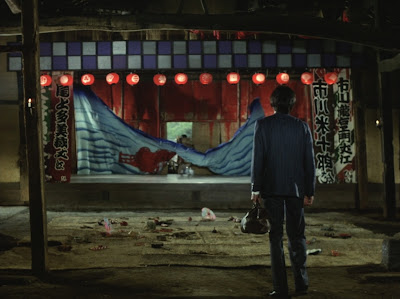Only now does it occur to me... that I have to say a few words in praise of KAGERO-ZA (1981), the second film in the Japanese director Seijun Suzuki's trilogy of Taishō-set, literary-supernatural Gothic romances. KAGERO-ZA is the middle film, bookended themetically by ZIGEUNERWEISEN (1980) and YUMEJI (1991), and it's my favorite of the three.
Suzuki was best known for his anarchic, jazzy, classy crime flicks he made for Nikkatsu in the 1960s [BRANDED TO KILL (1967), TOKYO DRIFTER (1966), and YOUTH OF THE BEAST (1963)], which careen to and fro with psychedelic, pop-art cool, like Jean-Pierre Melville collaborating with the Looney Tunes. They were an influence on filmmakers from Jim Jarmusch to Sam Raimi to George Miller to Quentin Tarantino. Eventually, Suzuki fell out of favor at Nikkatsu, was fired in 1968, and reemerged a decade later, making films at a slower rhythm, though still with an eye for astounding visuals.
The ZIGEUNERWEISEN trilogy probably qualifies as "slow cinema"––less appealing for those who want his tried and true bursts of arthouse adrenaline. But these were very well-received in Japan, where they were heavily nominated and honored at the Japanese Academy Awards.
About KAGERO-ZA, specifically: I suppose I'll tell you it's the story of a playwright during that hinge point of history known as the Taishō era, when liberal democracy crept into Japanese society between 1912 and 1926 (a sort of Weimar moment before the imperial ambitions of the Shōwa era fully formed). It has much to say about this, and love, and theater, and of Faustian bargains,

and it says it with such superlative and carefully crafted visuals.













No comments:
Post a Comment